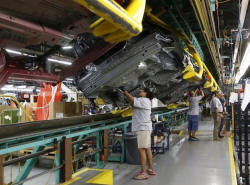|
First-quarter productivity
revised up to show it unchanged
 Send a link to a friend
Send a link to a friend
 [June 05, 2017]
WASHINGTON,
June 5 (Reuters) - U.S. worker productivity was not as weak as initially
thought in the first quarter, but the persistently soft trend is an
obstacle to faster economic growth. [June 05, 2017]
WASHINGTON,
June 5 (Reuters) - U.S. worker productivity was not as weak as initially
thought in the first quarter, but the persistently soft trend is an
obstacle to faster economic growth.
The Labor Department said on Monday nonfarm productivity, which measures
hourly output per worker, was unchanged in the last quarter. It was
previously reported to have declined at a 0.6 percent annualized pace.
The government also reported that the growth in labor costs at the start
of the year was not as strong as reported in May, which could cast
doubts on the tightening labor market's ability to unleash robust wage
growth.
The revision to first-quarter productivity was in line with economists'
expectations. Productivity increased at an unrevised 1.8 percent pace in
the fourth quarter.
Compared to the first quarter of 2016, productivity grew at a 1.2
percent rate, suggesting some improvement.
Productivity has increased at an average annual rate of 0.6 percent over
the last five years, below its long-term rate of 2.1 percent from 1947
to 2016, indicating that the economy's potential rate of growth has
declined.

That suggests the Trump administration could struggle to achieve its 3
percent annual gross domestic product growth target. The economy grew at
a 1.2 percent pace in the first quarter. It grew 1.6 percent in 2016 and
annual GDP growth has not exceeded 2.6 percent since the 2007-09
recession ended.
Economists blame low capital expenditure, which they say has resulted in
a sharp drop in the capital-to-labor ratio, for the weakness in
productivity. There are also perceptions that productivity is being
inaccurately measured, especially on the information technology side.
[to top of second column] |

Assembly workers work on the underside of 2015 Ford Mustang vehicles
on the production line at the Ford Motor Flat Rock Assembly Plant in
Flat Rock, Michigan, August 20, 2015. REUTERS/Rebecca Cook

Companies have been hiring more workers to maintain output.
First-quarter output per worker was revised up to a 1.7 percent growth rate from
the previously reported 1.0 percent pace.
The increase in output came as total hours worked increased at an upwardly
revised 1.7 percent rate. Hours worked were previously reported to have risen at
a 1.6 percent rate in the first quarter.
Unit labor costs, the price of labor per single unit of output, increased at a
2.2 percent pace in the first quarter instead of the previously reported 3.0
percent rate.
Compared to the first quarter of 2016, unit labor costs rose at a 1.1 percent
rate. Fourth-quarter unit labor costs were revised down to show them declining
at a 4.6 percent rate from the previously reported 1.3 percent pace of increase.
Wage growth remains sluggish despite the unemployment rate being at a 16-year
low of 4.3 percent.
(Reporting by Lucia Mutikani; Editing by Andrea Ricci)
[© 2017 Thomson Reuters. All rights
reserved.] Copyright 2017 Reuters. All rights reserved. This material may not be published,
broadcast, rewritten or redistributed. |